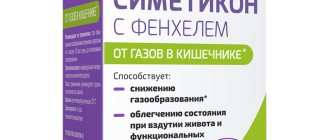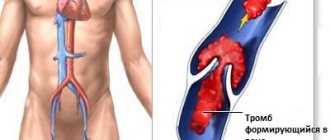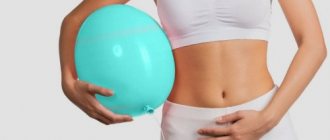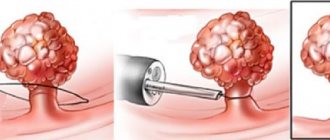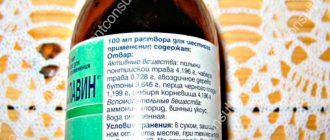Pharmacological properties
Pharmacodynamics.
Riabal selectively blocks peripheral m-cholinergic receptors of the mucous membrane of the digestive tract, bile and urinary tract and uterus. Riabal does not penetrate the geb. By selectively blocking M-cholinergic receptors, Riabal makes them insensitive to acetylcholine, which is formed at the endings of postganglionic parasympathetic nerves. The consequence of this is a decrease in the tone of the smooth muscles of the esophagus, intestines, gall bladder, bile ducts, urinary tract and uterus, as well as a decrease in the secretion of hydrochloric acid, pepsin, and exocrine activity of the pancreas. With prolonged use, Riabal does not have a negative effect on the function of the liver, kidneys, or hematopoietic tissue.
Pharmacokinetics. The drug is poorly absorbed from the gastrointestinal tract. Blood plasma clearance and renal clearance are 12.5 and 5.80 ml/min/kg body weight, respectively. T½ is 2.13 hours. It is excreted in feces and urine.
Journal "Child's Health" 5 (32) 2011
Relevance of the problem
Abdominal pain is a complex diagnostic and therapeutic problem in pediatrics and at the same time one of the common complaints of children and their parents, causing frequent visits to the doctor.
Most pediatricians believe that in 90–95% of children, abdominal pain is caused by functional pathology and only in 5–10% is associated with organic diseases of the digestive system [1, 2, 14, 19]. According to the Rome Consensus III (2006), functional disorders of the digestive system in newborns and children under 4 years of age include: infantile regurgitation, infantile rumination syndrome, cyclic vomiting syndrome, infantile colic, functional diarrhea, infantile difficult defecation and functional constipation [3, 4].
In children in the first months of life, abdominal pain manifests itself in the form of intestinal colic (from the Greek “kolikos”, meaning “pain in the colon”). The prevalence of infantile colic ranges from 5 to 19% among full-term infants and about 70% among premature infants [3, 4, 18].
To diagnose intestinal colic in infants, the so-called “rule of three” is used - crying for 3 or more hours a day, at least 3 days a week for 3 weeks in a row. The attack begins unexpectedly, against the background of complete well-being, more often during or shortly after feeding, accompanied by anxiety, crying, writhing legs, and regurgitation. Outside of an attack of intestinal colic, children have a good appetite, gain weight, and maintain a general positive emotional mood [7, 16].
There are a lot of theories and reasons explaining the occurrence of intestinal colic and regurgitation syndrome (regurgitation, vomiting) in children in the first year of life, but they are not fully understood. Most authors associate their appearance with impaired motor function of the intestine, accompanied by spastic contractions of smooth muscles and increased gas formation against the background of morphofunctional immaturity of the intestine and peripheral innervation, enzymatic failure of the gastrointestinal tract system, dysfunction of central regulation, and disturbances in the formation of intestinal microbiocenosis. A significant role is played by the nature of nutrition and the psycho-emotional state of the mother, as well as violations of breastfeeding techniques [3, 9, 15].
Treatment of intestinal colic in infants is gradual; it is individualized as much as possible and is aimed at normalizing the functions of the nervous system and gastrointestinal tract. Preference is given to routine, dietary, and psychotherapeutic recommendations. If there is no clinical effect, pharmacological correction is started [10, 13, 16, 17].
The motility of the intestinal muscles is regulated by peripheral and central mechanisms, in particular the parasympathetic system. Blockade of parasympathetic cholinergic influences makes it possible to prevent muscle spasms, intestinal hypermotility, hypersecretion of the stomach and pancreas [11, 12].
The most important requirements for modern drugs are high selectivity and minimization, as far as possible, of side effects and contraindications for use. In accordance with these requirements, selective M-anticholinergic blockers have been developed and are being widely introduced into modern clinical practice. The mechanism of their action is to selectively block peripheral M-cholinergic receptors in the digestive tract and biliary tract, which makes them insensitive to acetylcholine. The consequence of this is a decrease in the tone of the smooth muscles of the esophagus, stomach, intestines, gallbladder, and bile ducts [11, 16].
One of the modern selective M3 anticholinergic blockers of gastrointestinal smooth muscle cells is the drug Riabal (priphinium bromide), introduced in Ukraine. Riabal provides relief of abdominal pain syndrome, has a positive effect on the course of the disease, its prognosis and the quality of life of patients. A number of domestic pediatricians note the high effectiveness of Riabal in the treatment of various gastrointestinal disorders accompanied by vomiting and pain in children of different ages [5, 6, 8].
The neurotropic selective antispasmodic Riabal has a number of advantageous distinctive features. It selectively blocks M-cholinergic receptors of the abdominal and pelvic organs, corrects gastrointestinal motility and has virtually no effect on M-cholinergic receptors of other organs. When administered enterally, it has good bioavailability and is quickly excreted in the urine and partially in bile. By relieving spasms, Riabal eliminates pain, regurgitation, flatulence, vomiting, and stool disorders. Being a quaternary ammonium compound, it does not penetrate the blood-brain barrier. Riabal is available in several dosage forms - parenteral (solution for injection), tablets and syrup for young children. To ensure accurate dosing of the drug, the syrup form is equipped with a dispenser pipette. Riabal is approved for use in children from the first days of life.
The daily dose of the drug, divided into 3 doses, is 1 mg/kg body weight. The course of treatment for functional digestive disorders ranges from several days to 2 weeks.
The purpose of this study was to study the clinical effectiveness and safety of the use of the drug Riabal in the complex treatment of children in the first months of life with intestinal colic and regurgitation syndrome.
Materials and research methods
The study was carried out on 45 children aged from 3 weeks to 6 months - 28 (62.2%) boys and 17 (37.8%) girls. Regurgitation syndrome in combination with intestinal colic occurred in 32 (71.1%) children, isolated intestinal colic - in 13 (28.9%). The patients were divided into two groups: in the first group (main), consisting of 30 children, complex treatment included dietary and regimen measures, as well as the drug Riabal. The second (control) group consisted of 15 children, who were managed exclusively with routine measures and feeding recommendations. Dietary and routine recommendations included proper latching of the baby to the breast, feeding the baby on demand, reducing the intervals between feedings, creating a certain position for the baby after feeding, and the correct selection of formula for artificial feeding. In both groups, conversations were held with mothers and relatives to create a positive psychological climate around the child. All patients were randomized by age, gender and severity of the disease (Table 1).
The examination complex included: a clinical-anamnestic method, which has a verbal assessment of the leading clinical symptoms per day (pain, regurgitation (vomiting), anxiety associated with feeding, flatulence, sleep disturbance), recording the presence or absence of a symptom, general clinical laboratory tests of blood, urine, coprogram. According to indications, the microbial composition of the intestine was studied (stool culture for enteropathogenic and opportunistic bacterial flora), ultrasound examination of the abdominal organs and kidneys, and determination of the enzymatic activity of the digestive tract.
All children in the main group were prescribed Riabal orally 20 minutes before meals in recommended age-specific doses - 1 mg/kg/day in 3 divided doses. The duration of treatment was determined individually and averaged 14 days.
The effectiveness of treatment was assessed by the dynamics of complaints and objective data on the 3rd, 7th and 14th days of treatment.
The results obtained were processed using generally accepted mathematical methods of variation statistics.
Research results and discussion
When collecting anamnesis and analyzing documentation (histories of children's development), the following aggravating factors were identified in the medical history of the observed children: risk factors for perinatal lesions (early and late gestosis, anemia, placental dysfunction, ante- and intrapartum hypoxia), prematurity, artificial feeding.
28 (62.2%) children were breastfed, 5 (11.1%) were mixed-fed, and 12 (26.7%) were bottle-fed.
Most often, intestinal colic and regurgitation syndrome were observed among children in the first two months of life - in 27 babies (60%), among whom boys predominated - 17 (63%).
The clinical effectiveness of the drug Riabal in comparison with the control group is presented in table. 2.
Observations showed that relief of symptoms of intestinal colic and regurgitation syndrome occurred faster in the group of children whose complex therapy included Riabal. In children in the main group, the average duration of abdominal pain was significantly shorter than in the control group (7.46 ± 0.28 and 13.26 ± 0.24 days, respectively) (p Ј 0.001). According to the results of a survey of parents, children taking Riabal became calm on average on the 6th day of treatment (6.11 ± 0.22); in the control group, anxiety persisted for more than 11 days (11.46 ± 0.23). Similar dynamics were observed with regurgitation syndrome. Relief of regurgitation (vomiting) was noted on the 7th (6.86 ± 0.21) day of Riabal therapy versus 11.41 ± 0.22 days. in children in the comparison group (p Ј 0.001). A statistically significant better effect in the treatment of flatulence was also obtained in children of the main group. Intestinal bloating stopped much earlier with Riabal - in the main group by 7.46 ± 0.28 days, in the control group - by 10.12 ± 0.25 days. (p Ј 0.05). Reducing intestinal colic and flatulence contributed to the normalization of sleep in the children studied. In the main group, sleep was restored by 5.06 ± 0.15 days, which was significantly earlier than in the comparison group (9.25 ± 0.21 days) (p Ј 0.05).
At the end of the 2nd week of therapy with Riabal, all children (100%) of the main group achieved complete elimination of all clinical manifestations of gastrointestinal disorders. In the control group, clinical success by the end of the treatment course was achieved in only 11 (73.3%) infants.
During treatment with Riabal, not a single case of complications or side effects of the drug was reported.
conclusions
1. Riabal effectively and quickly relieves the syndrome of intestinal colic and regurgitation in newborns and children in the first months of life.
2. Riabal is a safe drug and meets the requirements for first-choice drugs in pediatrics.
Indications
Pain caused by spasms and hyperperistalsis of the digestive tract: with gastritis, gastric and duodenal ulcers, enteritis, colitis, after gastrectomy.
Pain associated with spasms and dyskinesia of the bile ducts: with cholecystitis, cholelithiasis.
Pain with pancreatitis.
Pain during urinary tract spasms: with stones in the urinary tract, bladder tenesmus, cystitis, pyelitis.
Prescribed before endoscopy of the stomach and gastrointestinal radiography.
Prescribed for vomiting.
Prescribed for dysmenorrhea.
Analogs
Analogues of Riabal are: Bebinos, Bromocriptine, Ganaton, Bimaral, Gaviscon, Digestal, Halidor, Domperidone, Gastenorm forte, Itomed, Carbopect, Gestid, Markalakt, Disflatil, Mezim forte, Iberogast, Metovit, Yogulakt, Milk of Magnesia, Maalox, Motonium, Metamol, No-shpa forte, Metoclopramide, Panzinorm Forte, Motilak, Penzital, Pancreatin, Rennie, Perinorm, Simikol, Sab simplex, Spasmonet, Smecta, Festal, Trimedat, Cholenzym, Hilak forte, Zeolate, Hofitol, Unienzim, Espumisan, No– spasm.
Application
Pills. Riabal tablets are used orally. children aged 6-12 years - 15-30 mg 2-3 times a day.
Children over 12 years of age and adults - 30–60 mg 3 times a day.
For acute severe pain, adults can be prescribed 90 mg per dose. If it is necessary to use prifinium bromide at a dose of 15 mg, the drug is prescribed in the appropriate dose or in the form of syrup.
Syrup. Children under 3 months - 1 ml every 6–8 hours; 3-6 months - 1-2 ml every 6-8 hours; 6-12 months - 2 ml every 6-8 hours; 1-2 years - 5 ml every 6-8 hours; 2–6 years – 5–10 ml every 6–8 hours.
The duration of the course of treatment is determined by the doctor individually.
Release form and composition
- coated tablets: biconvex, round, sugar coated, pink (20 pcs. in blisters, 1 blister in a cardboard box);
- solution for injection: colorless transparent liquid for parenteral administration (2 ml in dark glass ampoules, 6 ampoules in a cardboard box);
- syrup: liquid of sweet caramel taste, orange color (60 ml in dark glass bottles complete with a measuring pipette, 1 set in a cardboard box).
1 tablet contains:
- active ingredient: prifinium bromide – 30 mg;
- auxiliary components: starch, lactose, povidone, magnesium stearate, colloidal silicon dioxide, croscarmellose sodium, gelatin, talc, titanium dioxide, paraffin paraffin, carnauba wax, sucrose, FD&C red dye No. 3.
1 ml of solution for injection contains:
- active ingredient: prifinium bromide – 7.5 mg;
- auxiliary components: sodium chloride, hydrochloric acid, water for injection.
1 ml of syrup contains:
- active ingredient: prifinium bromide – 1.5 mg;
- auxiliary components: glycerin, propylene glycol, sodium benzoate, sucrose, liquid sorbitol, sodium citrate, sodium saccharin, monoammonium glycyrrhizinate, liquid caramel flavor, dyes: FD&C yellow No. 6 and FD&C red No. 40, purified water.
Contraindications
Riabal is contraindicated in patients with the following diseases:
- glaucoma: symptoms may increase due to increased intraocular pressure;
- urinary disorders caused by prostatic hypertrophy: symptoms may increase because they are caused by relaxation of the detrusor muscle and contraction of the bladder sphincter muscles; acute urinary retention;
- serious heart disease: symptoms may worsen as your heart rate increases;
- paralytic ileus: symptoms may worsen as gastrointestinal motility slows;
- hypersensitivity to prifinium bromide or any component of the drug.
Side effects
From the immune system: allergic reactions, including skin rashes, itching, hyperemia, urticaria, angioedema.
From the digestive tract: nausea, vomiting, constipation, dry mouth.
From the urinary system: urinary retention.
From the organ of vision: impaired accommodation, blurred vision.
From the nervous system: headache, dizziness, weakness, tremor.
From the cardiovascular system: hot flashes, tachycardia, increased blood pressure, palpitations.
The listed adverse reactions disappear when the dose is reduced or after discontinuation of the drug.
special instructions
It is believed that anticholinergics may lead to increased intraocular pressure.
In patients with prostatic hypertrophy, anticholinergics may cause a decrease in maximum bladder pressure and an increase in maximum bladder volume, sometimes leading to increased dysuria.
Prifinium bromide should be used with caution in patients with hyperthyroidism, as they tend to have a rapid heartbeat or tachycardia, which may increase symptoms.
Riabal should be used with caution in patients with congestive heart failure as the heart rate may be accelerated and symptoms may worsen.
The drug should be used with caution in patients with ulcerative colitis, since toxic megacolon may develop.
Priphinium bromide should be used with caution in patients sensitive to high environmental temperatures, since the sweat glands and body thermoregulation are suppressed; hyperthermia may occur.
Due to the anticholinergic effect of the drug, prifinium bromide should be used with caution in elderly patients, as symptoms such as impaired visual accommodation, dry mouth or urinary problems may occur (see SIDE EFFECTS).
Use with caution in chronic lung diseases, especially in young children and weakened patients, as well as in cases of brain damage in children, Down's disease, central paralysis in children.
The preparation contains sucrose and non-crystallizing sorbitol solution (E420) as excipients. If you have an intolerance to certain sugars, you should consult your doctor before taking this medicine.
The drug Riabal, syrup, contains the dye E110, which can cause allergic reactions.
Use during pregnancy and lactation. Pregnancy: The safety of prifinium bromide in pregnant women has not been proven.
The use of the drug during pregnancy and lactation is possible only when the expected benefit to the mother outweighs the potential risk to the fetus/child.
Children. The drug in syrup form is used in children under 6 years of age; in tablet form - in children over 6 years of age.
The ability to influence reaction speed when driving vehicles or working with other mechanisms. Riabal may cause disturbances in visual accommodation, which should be cautioned in patients engaged in potentially hazardous activities requiring alertness, such as driving or operating machinery.
Interactions
Priphinium bromide should be used with caution when taking the following medications simultaneously (table).
| Medicines | Signs, symptoms and treatment | Mechanism and risk factors |
| Tricyclic antidepressants (imipramine; amitriptyline). Phenothiazines (chlorpromazine). Antihistamines (diphenylhydramine) | Due to the anticholinergic effect, adverse reactions may develop (impaired visual accommodation, dry mouth, difficulty urinating) | Since prifinium bromide and these drugs have an anticholinergic effect, their effect may be further enhanced |
| MAO inhibitors | Due to the anticholinergic effect, adverse reactions may develop (impaired visual accommodation, dry mouth, difficulty urinating) | As drug metabolism slows, anticholinergic effects may be enhanced |
The anticholinergic effect of the drug can be potentiated with the simultaneous use of antihistamines, tricyclic antidepressants, neuroleptics of the group of phenothiazine derivatives, and disopyramide.
Enhances the effect of narcotic analgesics, antidepressants, antipsychotic drugs, neuroleptics, antiparkinsonian and M-anticholinergic drugs.
Note!
Description of the drug Riabal table. p/o 30 mg No. 20 on this page is a simplified author’s version of the apteka911 website, created on the basis of the instructions for use.
Before purchasing or using the drug, you should consult your doctor and read the manufacturer's original instructions (attached to each package of the drug). Information about the drug is provided for informational purposes only and should not be used as a guide to self-medication. Only a doctor can decide to prescribe the drug, as well as determine the dose and methods of its use.
Price
The drug Riabal is relatively inexpensive, even though, depending on the name of the pharmacy chain and regions, its price fluctuates in the range of several tens of rubles or hryvnia.
Cost in Ukraine
In Ukrainian pharmacies you can buy the medicine from 27.5 to 44 hryvnia for a pack of 20 tablets.
Cost in Russia
In Russian pharmacies the drug costs an average of 280-295 rubles per pack of 20 tablets.
Video on the topic: Bloating and flatulence. Causes of the problem and how to get rid of it
